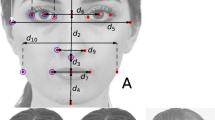Abstract
The face attractiveness from 3D representation is still in the infancy stage. In this paper, we investigate the role of 3D face geometry in facial beauty perception. Driven by heuristic rules, the aesthetics-aware geometric features are extracted, including features directly extended from 2D task to the 3D space, i.e., the global shape and Euclidean ratios, as well as features exclusively designed for 3D face structure, i.e., the geodesic ratios and region-based curvatures. A benchmark dataset with face models and attractiveness ratings is developed for facial attractiveness computation. Experimental results demonstrate the significance of 3D geometric features in capturing the face geometry over their 2D counterparts, and the advantages of the exclusive features in characterizing facial attractiveness over the extended features.






Similar content being viewed by others
Data availability
Enquiries about data availability should be directed to the authors.
References
Bottino A, Simone MD, Laurentini A, Sforza C (2012) A new 3-D tool for planning plastic surgery. IEEE Trans Biomed Eng 59(12):3439–3449
Bottino A, Laurentini A (2012) The intrinsic dimensionality of attractiveness:a study in face profiles. In: Progress in pattern recognition, image analysis, computer vision, and applications, pp. 59–66
Canavan S, Liu P, Zhang X, Yin L (2015) Landmark localization on 3D/4D range data using a shape index-based statistical shape model with global and local constraints. Comput vis Image Underst 139:136–148
Canavan S, Yin L (2015) Feature detection and tracking on geometricmesh data using a combined global and local shape model for face analysis. In: IEEE international conference on biometrics theory, applications and systems, pp. 1–6
Chang CC, Lin CJ (2011) Libsvm: a library for support vector machines. ACM Trans Intell Syst Technol 2(3):27:1-27:27
Chiang WC, Lin HH, Huang CS, Lo LJ, Wan SY (2014) The cluster assessment of facial attractiveness using fuzzy neural network classifier based on 3D moir´e features. Pattern Recogn 47(3):1249–1260
Dijkstra EW (1959) A note on two problems in connection with graphs. Numer Math 1(1):269–271
Dryden IL, Mardia KV (1998) Statistical shape analysis. John Wiley & Sons Ltd, Chichester
Efroymson MA (1960) Multiple regression analysis. Math Meth Digital Comput 1:191–203
Farkas LG (1994) Anthropometry of the head and face, 2nd edn. Raven Press, New York
Gunes H (2011) A survey of perception and computation of human beauty. In: The 2011 joint ACM workshop on human gesture and behavior understanding, pp 19–24
Gupta S, Markey MK, Bovik AC (2010) Anthropometric 3D face recognition. Int J Comput Vis 90(3):331–349
Han W, Chen F, Sun F (2020) Can we extract 3D biometrics from 2D images for facial beauty analysis. In: International conference on computing and pattern recognition, pp. 213–217
Jain DK, Shamsolmoali P, Sehdev PS (2019) Extended deep neural network for facial emotion recognition. Pattern Recognit Lett 120:69–74
Jang KS, Bayome M, Park JH, Park KH, Moon HB, Kook YA (2017) A three-dimensional photogrammetric analysis of the facial esthetics of the Miss Korea pageant contestants. Korean J Orthod 47(2):87–99
Kalayci S, Ekenel HK, Gunes H (2014) Automatic analysis of facialattractiveness from video. In: IEEE international conference on image processing, pp. 4191–4195
Kim JS, Choi SM (2009) Symmetric deformation of 3D face scans using facial features and curvatures. Comput Anim Virtual Worlds 20(2–3):289–300
Koenderink JJ, Doorn AJV (1992) Surface shape and curvature scales. Image vis Comput 10(8):557–564
Laurentini A, Bottino A (2014) Computer analysis of face beauty: a survey. Comput Vis Image Underst 125:184–199
Liao Q, Jin X, Zeng W (2012) Enhancing the symmetry and proportion of 3D face geometry. IEEE Trans Vis Comput Graphics 18(10):1704–1716
Liu S, Fan Y-Y, Samal A, Guo Z (2016) Advances in computational facial attractiveness methods. Multimed Tools Appl 75(23):16633–16663
Liu S, Fan Y-Y, Guo Z, Samal A, Ali A (2017) A landmark based data-driven approach on 2.5D facial attractiveness computation. Neurocomputing 238:168–178
O’Toole AJ, Price T, Vetter T, Bartlett JC, Blanz V (1999) 3D shape and 2D surface textures of human faces: the role of “averages” in attractiveness and age. Image Vis Comput 18(1):9–19
Rhazi ME, Zarghili A, Majda A, Oufkir AA (2022) 3D facial attractiveness enhancement using free form deformation. J King Saud Univ Comput Inf Sci 34:3497–3505
Xiao Q, Wu Y, Wang D, Yang Y-L, Jin X (2021) Beauty3DFaceNet: deep geometry and texture fusion for 3D facial attractiveness prediction. Comput Graph 98:11–18
Yin B (2005) The BJUT-3D large-scale Chinese facedatabase. In: Beijing university of technology, accessed: http://www.bjpu.edu.cn/sci/multimedia/mullab/3dface/facedatabase.htm
Zhang D, Chen F, Xu Y (2016) Computer models for facial beauty analysis. Springer, Basel, p 4
Funding
This work was supported in part by the National Natural Science Foundation of China under Grant 61902435, in part by Hunan Provincial Natural Science Foundation of China under Grant 2019JJ50808, and in part by the Fundamental Research Funds for the Central Universities of Central South University.
Author information
Authors and Affiliations
Corresponding author
Ethics declarations
Conflict of interest
The authors declare that they have no conflict of interest.
Ethical approval
This article does not contain any studies with human participants or animals performed by any of the authors.
Additional information
Publisher's Note
Springer Nature remains neutral with regard to jurisdictional claims in published maps and institutional affiliations.
Rights and permissions
About this article
Cite this article
Liu, S., Huang, E., Xu, Y. et al. Computation of facial attractiveness from 3D geometry. Soft Comput 26, 10401–10407 (2022). https://doi.org/10.1007/s00500-022-07324-0
Accepted:
Published:
Issue Date:
DOI: https://doi.org/10.1007/s00500-022-07324-0




